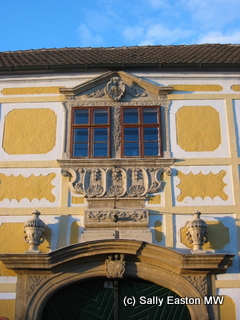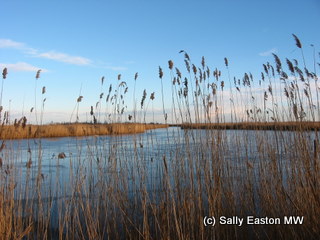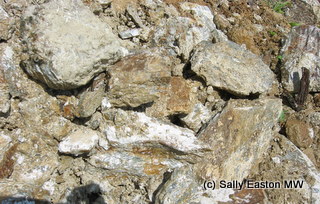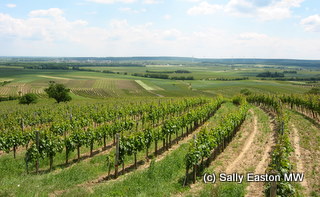Austrian reds
A version of this article first appeared in Harpers Wines and Spirit, 2006.
Country Blaufränkisch: Austria’s ABC

Rust architecture
Austria, with less than one per cent of global wine production is a hot-house of innovation and aspiration for its red wine producers, who account for about 35% of production, and increasing. It is only in the last generation that any sort of serious red wine tradition has developed. And as was seen, for example, with the rapid evolution of Australian chardonnay from heavily worked and highly oaked to increasingly moderated expressions and unoaked styles, so Austria is in the midst of revolution with its reds, finding its best expressions, and all on a microscopic scale of vineyard holding and vineyard site which seems more reminiscent of Burgundy, also with family-owned, family-named wineries. Factor in the different indigenous grape varieties that bless Austria and a jigsaw puzzle of minutiae emerges to delight the connoisseur and confound the debutant.
Just a generation ago, Austrian wine was made to be drinkable straight away, and reds were vinified almost as white wines – low tannins, some residual sugar – a red coloured liquid without any of the features of red wine, often to meet market demand, especially from Germany, which has undergone a parallel red wine reform. Dr. Josef Schuller MW, managing director of the Austrian Wine Academy said: “the tradition of producing great red wines was not there, so what evolved in the 80s and 90s were deep, darkly coloured wines. Through the 80s, the trend was to stop producing reds with residual sugar, and to start using new wood. It was in the 80s that malolactic fermentation was a hot topic in Austria” Schuller added that the taste of new oak – ‘neuerl’ used to be considered a fault by the wine quality board, and that this changed only in the 80s. A mid 1980s visit by Burgenland producers to Bordeaux helped revolutionise the red wine landscape. Structure, earthy dryness, tannin, power, oak became the new bywords for quality, and the evolution of style and place continues.
There are fewer than 12,000 hectares (ha) of red grape vineyards in all of Austria. While there are smatterings of red vineyards throughout the country, even in the whiter than white renowned growing districts, Burgenland is the heartland, homeland and hero region for red wine production with over 40% of red plantings. The vast Weinviertal, to the north of Vienna, also has big holdings, mainly of zweigelt and portugieser.
The four areas of Burgenland comprise the key red wine areas, and all are influenced to a greater or lesser extent by the continental Pannonian climate coming from the Hungarian steppes to the east, and by the large, shallow lake Neusidedl.
- Neusiedlersee – to the east of the lake
- Neusiedlersee-Hügelland – to the west of the lake
- Mittelburgenland – to the south of the lake
- Südburgenland – a little bit further to the south of the lake
Neusiedlersee

Neusiedlersee
Neusiedlersee is the only middle European steppe lake, and it is right at the western edge of the Pannonian plains. This large shallow lake, with an average depth of one metre, at about 100m above sea level, lake regulates climate in an important way. While up to 40% of the lake evaporates each year, creating humidity for botrytis to develop for sweet wines, a little further around the lake, black grapes come into their own. Zweigelt and blaufränkisch dominate, with some pinot noir, sankt laurent, cabernet sauvignon and merlot.
While the axis of Apetlon and Illmitz conjure images of rich, sensuous sweet wines, it is the trapezium of Gols, Mönchhof, Podersdorf, and Frauenkirchen on the north east perimeter of the lake that is the core of red production.
From the northernmost tip of the lake a distinct ridge runs from the north west to the south east immediately above Gols and Mönchhof, 30-50m above the plains. On the gentle slopes of this ridge are some of the best vineyard sites for reds on this side of the lake, such as Ungerberg, Altenberg, Salzberg and Gabarinza. The ridge leads up to the Parndorf plateau, where, Axel Stiegelmar of Weingut Juris says: “It’s slightly cooler because of the wind, therefore earlier ripening varieties such as pinot noir and sankt laurent are better suited.” The slopes on the other hand are deemed best for later ripening blaufränkisch, and merlot.
This is the home of the Pannobile group of growers. One of the features of Austrian wine growing is the number of growers’ groups, where usually a dozen or so growers have banded together to promote their wines, or to set a standard for what they think is the best that they or their area can produce. So for a wine to carry the ‘Pannobile’ label, it must be a minimum 85% local varieties. It is usually a blend, from different soils and different grape varieties. Gerhard Pittnauer, relative newcomer to the Pannobile group said: “North Burgenland changed to a red wine region about 20 years ago. It is a perception of minimum quality, with group dynamics and competition for quality, and shared costs of marketing. It’s a good way to make a region better known. Pannobile should express quality and typicity, also personality of the winemaker. It is a good climate for discussion.”
Helmuth Renner one of the founding members of the Pannobile group, typifies the small scale of production in Austria. Renner is the first generation of the family who works only with wine. Their business used to be mixed farming, as in much of this area. His grandfather, who was a miller, started wine production in 1950. And his father was one of the first to plant chardonnay, in the 60s. Renner said of the region “production is split 50:50 red and white, but in the next 10 to 20 years, it will be 70% red.” Their own production is 80% red, with nearly all his vineyards up and near the slopes.
A new group – Select Gols – has recently established itself, focusing purely on indigenous grape varieties: zweigelt, pinot noir, sankt laurent and blaufränkisch. Pinot noir has been in Austria for long enough to count as indigenous.
The growers’ groups reflect more general winemaking trends, especially whether to blend solely indigenous varieties, or to add the likes of cabernet sauvignon, merlot or syrah. The Pannobile, for example, can have up to 15% of international varieties in the blend. Debate on these style differences will continue: as elsewhere in the world, when it is blended with indigenous varieties, there comes a point at which cabernet sauvignon dominates a blend and indigenous flavours are lost.
On this subject Josef Umathum says: “I want to have Austrian fruit in the wine. In the 80s and 90s there were lots of blends, now the trend is back to single varietal, and back to Austrian varieties, back to blaufränkisch and sankt laurent and less to pinot noir.”
Gernot and Heike Heinrich, are master craftspeople of both varietal wine and single vineyard wines (blends), with that international twist. They own 10ha of the 14ha Gabarinza vineyard, as well as part of the Salzberg vineyard. Heinrich says he uses “the upper slope, with gravel and more humus for zweigelt, the middle slope, with sand, clay, no humus for blaufränkisch, and the lower slope again for zweigelt. Zweigelt needs more humus as it does not like to suffer, and blaufränkisch does better on heavier soil.”
Heinrich says: “zweigelt has darker fruit, more black cherry, softer tannin, fuller body, lacks the length, tannin, structure of a good blaufränkisch, therefore it´s good for blending.” Both his Salzberg and Gabarinza single vineyard wines are blended with merlot, which he says offers ripeness, power and ageing potential.
Neusiedlersee-Hügelland
Over on the west side of the lake, Rust is the centre for sweet wine production, with red wine producers located here too, and the Leitha Hills to the west of the lake provide vineyards for dry whites and reds.

Leitha Hills soils
The slate and limestone Leitha Hills, where a mix of red and white varieties are grown, range up to 300-325m above sea level, and provide a 35km border to the north west, protecting the vineyards of Neusiedlersee-Hügelland from cool northerly winds. Vineyards are located on the gentle south and south east facing slopes, garnering warmth from the lake.
Hans Nehrer said “Blaufränkisch is late ripening so not found so high up the slopes. Zweigelt can go higher and pinot noir, because both are earlier ripening. The sun goes down pretty fast too, so we have good diurnal temperature variations which can be up to 20°C.”
Mittelburgenland
To the south of the lake and into the pre-Alps, this hilly, forested region is pitched as ‘blaufränkisch country’, and wine production, on 2000 ha, three quarters of it red, is concentrated in a west-east running series of slopes from Neckenmarkt and Horitschon in the west to Deutschkreutz in the east, right on the Hungarian border. Before 1921, the region’s main city was Sopron, which has remained Hungarian. Here soils are deep, heavy sands and loams, and some of the vines qualify for old status at up to 80 years.
This broad valley range, 230 to 350m above sea level is surrounded on three sides by hills, the Odenburger Hills to the north, Rosalien Hills to the west, and Geschriebenstein Hills to the south, with the weather mostly coming from the east, unless rains and storms come up from the south. For this reason, cover crops are more likely to be found in this region. Franz Weninger of Weingut Weninger said: “The climate is influenced by Neusiedlersee, but there is no direct contact. Warm air seeps up the valley from the east.”

Mittelburgenland
As befits its moniker, blaufränkisch is the main grape of the region, late-ripening, during the middle to end of October. It’s cooler here, a bit higher, a bit wetter, harvest is maybe a week later, so the acidity of blaufränkisch is a bit fresher, and fruit characters trend to crisp red and sour cherry, with a peppery and sometimes herbaceous note; tannins can be more linear. But the degree of freshness and lift offered by a hint more acidity adds an element of elegance to the best wines that’s not always found closer to the lake.
There is more chalk in the soil at Neckenmarkt, vines are on the higher slope, up to 350m, and the top site, qualitatively and altitudinally, Hochberg, has deep water storage capability in its loam soils. On the south side, Horitschon, 100m lower, has loam and loess soils. Over to the east, Deutschkreutz has more gravel, with lighter, loess soils and stones which retain moisture and warmth, giving fuller wines with creamy texture and heavier tannin.
Anton Iby‘s red wines come from the three main Horitschon vineyards: Hochäcker, Dürrau, Gfanger. He spoke of the extreme content of clay in the heavy soil, saying these are the oldest vineyards in Horitschon, because they could not grow white varieties in the heavy soil, and so had not been replanted. He said: “fruit and high ripe phenols are important. I learnt a lot in Priorat about fine ripe structure – most is fruit, next is tannin and the acid level should be present, but not dominant.”
Roland Velich, of Apetlon renown, is working with some aplomb in Mittelburgenland under the Moric label with blaufränkisch. He said: “we´re in a northern country, the aim is cool, elegant wines driven by finesse. It’s warmer than Burgundy. Blaufränkisch ripens a little before cabernet sauvignon. Sometimes we get the spicy expression of syrah but we can get the silky textures of pinot noir”
“Burgenland has a Pannonic situation; it is more connected with wines of Hungary. We aim for origin, typicity, the character of the grape varieties and not of oak; elegance of fruit, a mineral nerve which keeps freshness in the wine and makes it ageworthy. A classic European expression. should be drinkable, we don’t want to produce monsters.” They are using notably tiny amounts of new oak.
Südburgenland
About 100km south of Horitschon, and with 450 dispersed hectares, Südburgenland is the small southern settlement of red wine production in Austria. With a mild Pannonian climate, old blaufränkisch is grown in iron-rich soils, adding an element of spice and concentration in the best examples. Production is focused on neighbouring villages of Eisenberg and Deutsch-Schützen.
While there are about 500 producers in Südburgenland, many of them hobbyists, Krutzler is the most noted producer, especially with the Perwolff blend of blaufränkisch with 10% cabernet sauvignon.
The overt oak odyssey: over and out?
For sure there are plenty of tasty styles of wine made in big old wood and other inert vessels, but it is the top cuvées that make the noise for Austrian reds. For these, the honeymoon period is probably not over yet for ostentatious, overt oak, but some of the best producers seem to be drawing back a little from its sometimes dominating vanilla and cream, toast and spice notes, letting the fruit shine through. Moric may be one of the vanguard in this respect.
Franz Weninger says “you have to be really careful with wood. Blaufränkisch is the great red variety of Austria, with great ageing potential. It is mainly the fruit-acid balance which holds the wine, not the tannin. Barrique was quite heavy in the last 10 years, most winemakers are now finding the right way of using wood.”



